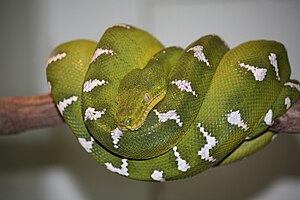Green dog's head swivel
This article has been registered in the quality assurance biology for improvement due to formal or content-related deficiencies . This is done in order to bring the quality of the biology articles to an acceptable level. Please help improve this article! Articles that are not significantly improved can be deleted if necessary.
Read the more detailed information in the minimum requirements for biology articles .
| Green dog's head swivel | ||||||||||||
|---|---|---|---|---|---|---|---|---|---|---|---|---|

Green dog's head curler ( Corallus caninus ) |
||||||||||||
| Systematics | ||||||||||||
|
||||||||||||
| Scientific name | ||||||||||||
| Corallus caninus | ||||||||||||
| ( Linnaeus , 1758) |
The green dog-headed boa ( Corallus caninus ), also dog-head snake or green dog-head snake, is a snake that is found in the Amazon basin of Peru , Ecuador , Brazil and the Guyana countries. The habitat consists of closed, moist forest areas ( tropical rainforests ) mostly in the vicinity of water.
description
This species has a slightly flattened body and a very large head. The snake has a strong green basic color with white, irregular spots and bands on the back. The color on the belly varies from dirty white to light yellow. Her eyes are also greenish in color. Young animals are brick-red to red-brown at birth. A change in color requires several skins, initially green spots appear, which gradually displace the youthful color. The length is given as 200-300 cm. All Corallus species have conspicuous large sensory pits on the upper and lower lip ( labial pits ) with which warm-blooded animals can be located in the dark. The green dog-headed boa has very long, backward-curved front teeth, which ensure a successful bite through a dense bird dress, these also serve to hold the prey. The strong tail helps her move almost silently through the canopy of the trees.
distribution
It occurs in the upper levels of the tropical rainforests of Brazil and Guyana , preferably at the forest edges.
Way of life
The green dog-headed boa is very closely adapted to life in trees, so branch forks densely surrounded by leaves are preferred as resting places. The body is typically placed in loops over the branch and the head rests on the body. This makes the snake almost invisible. In addition to birds, the main diet also consists of small mammals and lizards. It kills its prey with its powerful bite and then devours it whole. When danger threatens, they become very aggressive and bite. Their bite is not poisonous.
Reproduction
The female gives birth to 15–20 live young per litter. These are independent immediately after the birth. The young are strikingly orange, red or yellow in color. They do not get their greenish appearance until they are one year old. To protect against predators, they hide in the foliage of the trees.
Hazards and protective measures
Although these animals are illegally caught for the international pet trade, this species is still very widespread and is listed by the IUCN in the Least Concern category. In Guyana and Venezuela, catch and trade restrictions apply to protect this species.
literature
- Jiří Felix (ed.), Alena Čepická: America's fauna in color. Translated from the Czech by Jaroslav Konšal. Karl Müller Verlag, Erlangen 1989, book no. 1/12/05 / 52-03, p. 81.
- David Burnie (Ed.), Mariele Radmacher-Martens: Animals: The large picture encyclopedia with over 2,000 species. Translated from the English by Gabriele Lehari. Dorling Kindersley, Munich 2012, ISBN 978-3-8310-2232-8 , p. 390.
- Wilhelm owner (ed.), Erna Mohr: Encyclopedia of the animals. Volume 1, Weltbild, Augsburg 1991, ISBN 978-3-89350-360-5 , p. 263.
Web links
- Corallus caninus in The Reptile Database
- Corallus caninus inthe IUCN Red List of Threatened Species 2018.2. Posted by: Oubotar, P., Schargel, W. & Rivas, G., 2014. Retrieved January 10, 2019.
- Pictures and comparison to Corallus batesi on www.corallus.de